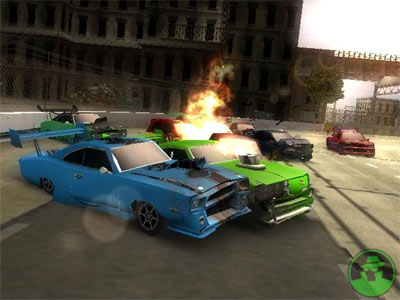It's going to take a development miracle over the next few weeks for Crash's graphics and speed to come close to matching those of Burnout 3. Right now, the cars look about as basic as it gets (despite a fairly deep customization system common in many modern racing games), and though the action moves along swiftly, even a burst of nitro fails to rival the breakneck feel of coasting along at normal speed in Burnout 3.
To be fair, though, there's a lot happening onscreen, with relatively thin tracks and 16 cars equaling lots of chaos, and no doubt, a lot of processing power being utilized. The key to each race seems to be to break away from the pack early on and to stay up there, because the longer you're stuck with a wall of battling cars ahead of you, the more time those ahead have to further their lead. The nitro meter you acquire after one lap might help you inch closer, but odds are you'll need a few more nitro boosts along the way to make a legitimate run. And the only way to get that? Wrecking other cars.

If you check out the screenshots for this game, you'll notice a red meter on the lower portion of the screen, just above the blue nitro meter. This essentially acts as your car's "health," and once it depletes all the way, your vehicle goes kablooey along with any hope you had at placing -- unlike Burnout 3, you wreck, you're outta there. It's kind of fun to watch the number of competitors deplete as they wreck and are eliminated -- it really helps your chances to catch up or to maintain a lead.
That is, unless the wreckage gets in your way. One thing Crash has that Burnout 3 actually does not is wreckage that stays on the track throughout the entire race. Whether it be an errant spoiler being tossed about the track as cars speed over it or the remains of a totaled car itself, wreckage can really screw you over if you're not careful. If that weren't enough, cars also leak oil, which is very likely to become a wall of flames later on in a race. And needless to say, your little red meter at the bottom of the screen doesn't appreciate driving through a raging fire if it can possibly be avoided -- sometimes it can't!
As if 16 cars on the track weren't enough -- and yes, that means 16 actual humans if you play online -- the short laps also add to the carnage. It takes about 30 seconds to run a typical lap, and many of the courses crisscross as a figure 8 would. This makes for plenty of opportunities to pass the leader before someone 15 seconds behind him delivers a perfect T-bone, instigating a massive pileup. Of course, if you're not careful, YOU could be said T-bonee -- maybe even a T-boner who screws up in the first place.





